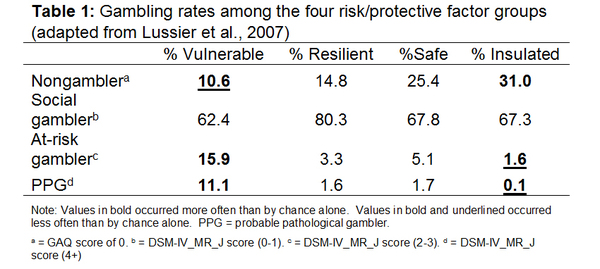Researchers have focused much attention on identifying high risk populations and risk factors involved in addictive behaviors such as disordered gambling. Less attention has been paid to resilience and the role it plays in preventing risky behavior in adolescent populations. Luthar and Cicchetti (2000) define resilience as a person’s ability to adapt positively (e.g., not exhibit emotional, behavioral, and social problems) in the face of adversity (i.e., negative life events). In this edition of The WAGER we examine research by Lussier, Derevensky, Gupta, Bergevin, & Ellenbogen (2007) that investigated resilience and youth gambling behavior.
Researchers recruited 1,273 participants aged 12 to 19 from 12 schools across Montreal, Quebec, Canada. Students responded to a 300 item anonymous survey during a 50 minute class period. The survey included: the Gambling Activities Questionnaire (GAQ; Gupta & Derevensky, 1996) and the Diagnostic and Statistical Manual of Mental Disorders Multiple Response Juvenile (DSM-IV-MR-J; Fisher, 2000) to ascertain gambling activity, as well as the Individual Protective Factors Index (IFPI; Springer & Phillips, 1992) to assess protective and risk factors.
Analyses revealed that 7.2% and 3.2 % of the sample were classified as at-risk and probable pathological gamblers (PPGs) respectively. The researchers used tertile splits of both the protective and risk factors and retained only the extreme highest and extreme lowest scores to form four groups of subjects: vulnerable (high risk-low protective), resilient (high risk-high protective), safe (low risk-low protective), and insulated (low risk-high protective). Researchers found that among subjects in the vulnerable group, non-gamblers were underrepresented and there were more of the at-risk and PPGs than in the total sample. In the insulated group, there were more non-gamblers and fewer at-risk and PPGs. (see Table 1). Further examination revealed that the mean gambling severity score for the resilient group (M=0.3, SD=0.78) was less than a third of that of the vulnerable group (M=1.12 SD 1.74), even though the groups had similar levels of risk.
The results are promising, but the study has a few limitations. The research design is cross-sectional and does not allow researchers to establish a temporal relationship. Surveys were anonymous, but often conducted under the supervision of a teacher. This might lead to underreporting of risk factors and gambling behavior. Despite these limitations, the finding that the resilient group, although at high risk for developing problems, resembled the low risk groups in its prevalence of disordered gamblers , suggests that this group was indeed protected. This is important from a public health perspective because it is easier to modify protective factors such as personal competence than it is to remove certain familial or environmental risk factors. Future prevention efforts should focus more attention on increasing protective factors to prevent addictive behaviors.
What do you think? Comments can be addressed to John Kleschinsky.
References
Fisher, S. (2000). Developing the DSM-IV criteria to identify adolescent problem gambling in non-clinical populations. Journal of Gambling Studies, 16(253-273).
Gupta, R., & Derevensky, J. L. (1996). The relationship between gambling and video game playing behavior in children and adolescents. Journal of Gambling Behavior, 12, 375-394.
Lussier, I., Derevensky, J. L., Gupta, R., Bergevin, T., & Ellenbogen, S. (2007). Youth gambling behaviors: An examination of the role of resilience. Psychology of Addictive Behaviors, 21(2), 165-173.
Luthar, S. S., & Cicchetti, D. (2000). The construct of resilience: implications for interventions and social policies. Development and Psychopathology, 12(4), 857-885.
Springer, J. F., & Phillips, J. L. (1992). Extended national youth sports program, 1991-1992 evaluation: II. Individual protective factors index (IFPI) and risk assessment study. Folsom, CA: EMT Associates.





